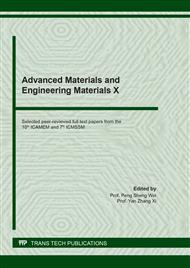p.339
p.344
p.350
p.358
p.363
p.369
p.375
p.382
p.387
Study on Low Temperature Conduction Mechanism of Al Doped ZnO/SiO2/ P-Si Heterojunction
Abstract:
The 3 at% Al doped ZnO thin films were deposited on p-Si substrate with a native SiO2 layer by spray pyrolysis method. Low temperature conduction behaviors were studied by analysis of impedance spectroscopy and low temperature ac conductivity. The results of impedance spectroscopy showed that the grain boundaries contributed to the resistivity of Al doped ZnO/SiO2/p-Si heterojunction. The calculated activation energy was 0.073 eV for grain boundaries. The equivalent circuit to demonstrate the electrical properties of Al doped ZnO/SiO2/p-Si heterojunction was a series connection of two parallel combination circuits of a resistor and a universal capacitor. Low temperature ac conductivity measurements indicated that the conductivity increased with temperature. Low temperature conductivity mechanism was electron conductivity, and the activation energy was 0.086 eV.
Info:
Periodical:
Pages:
363-368
Citation:
Online since:
November 2021
Authors:
Keywords:
Price:
Сopyright:
© 2021 Trans Tech Publications Ltd. All Rights Reserved
Share:
Citation:


